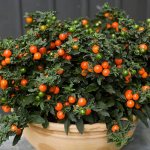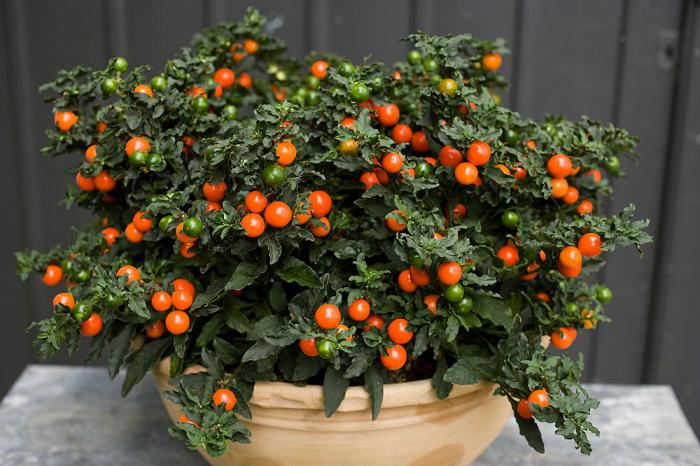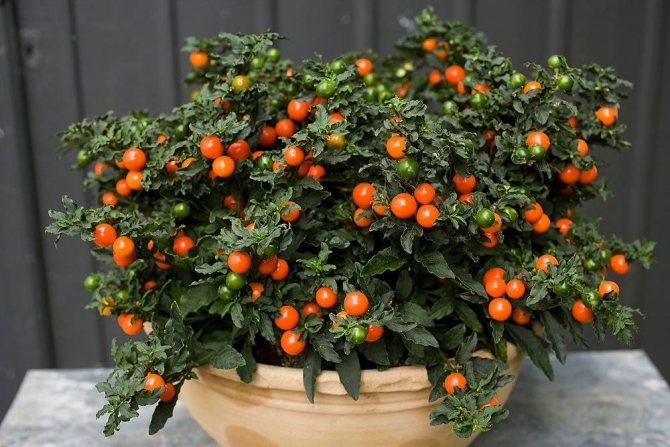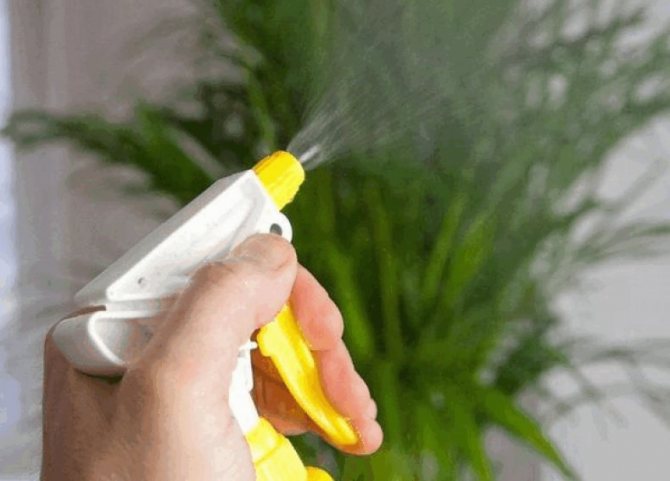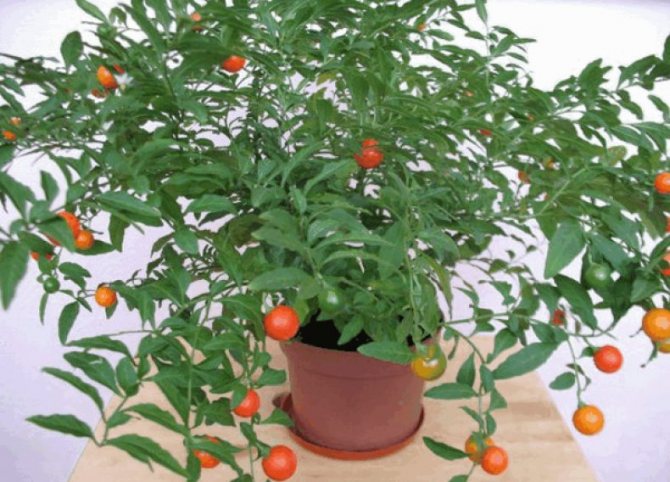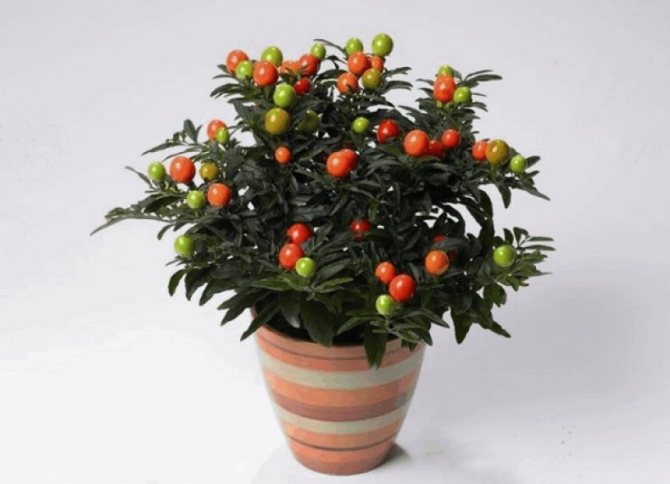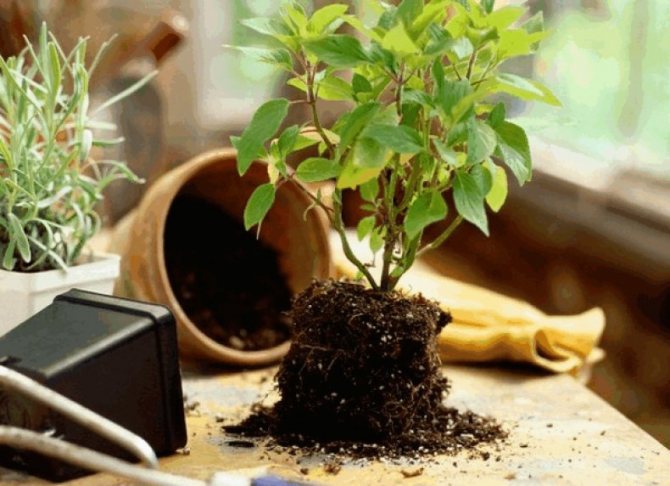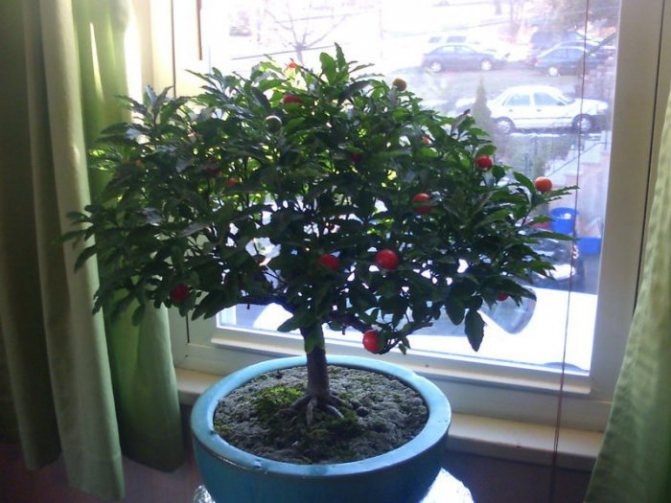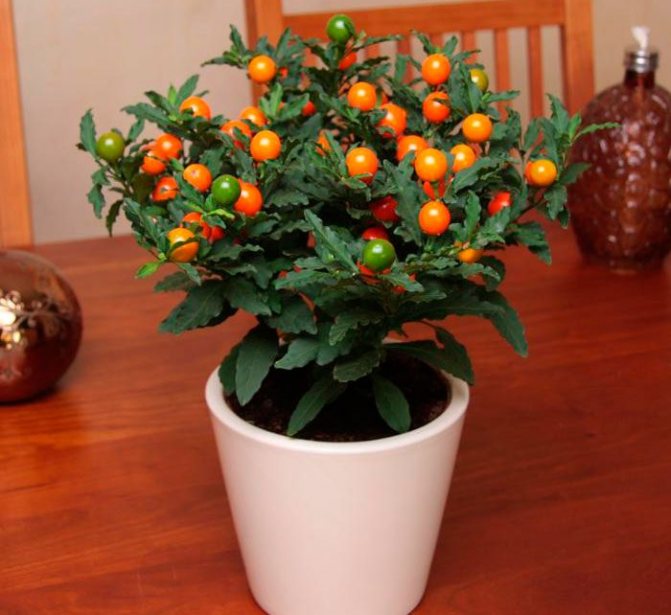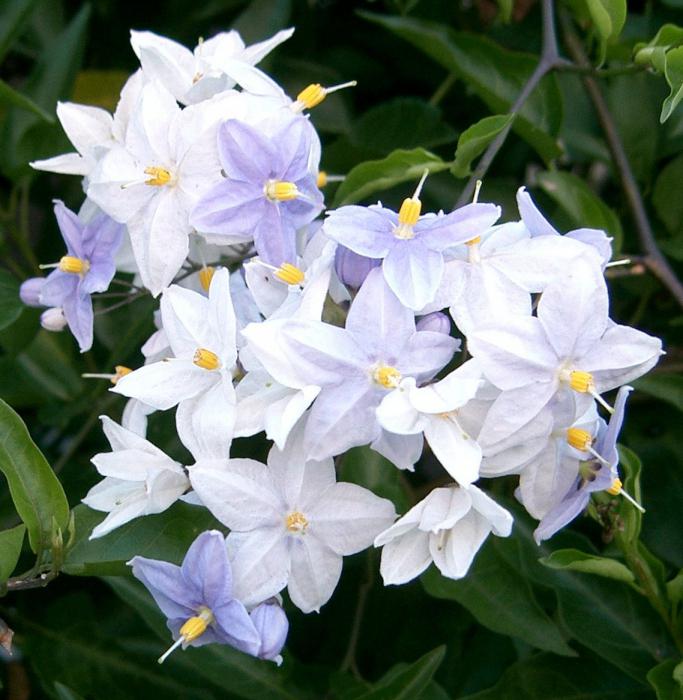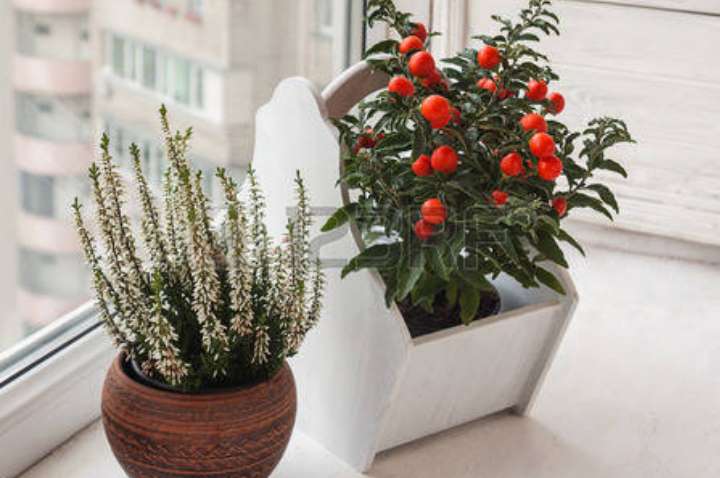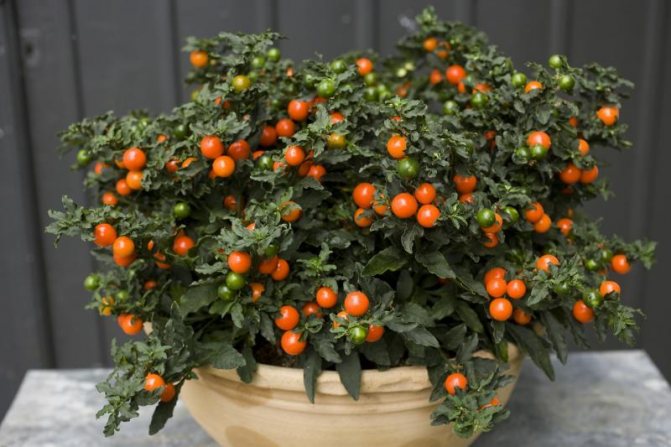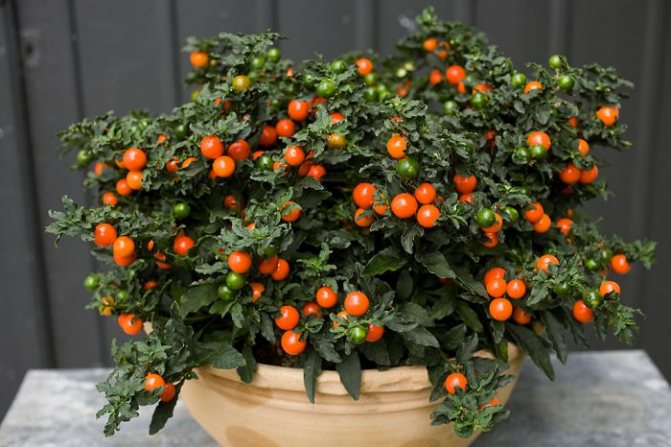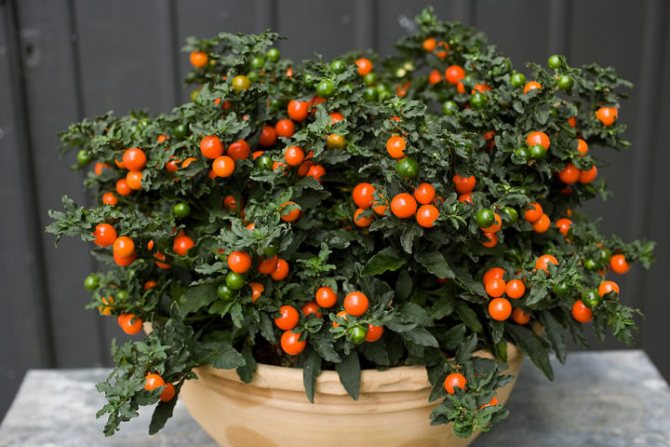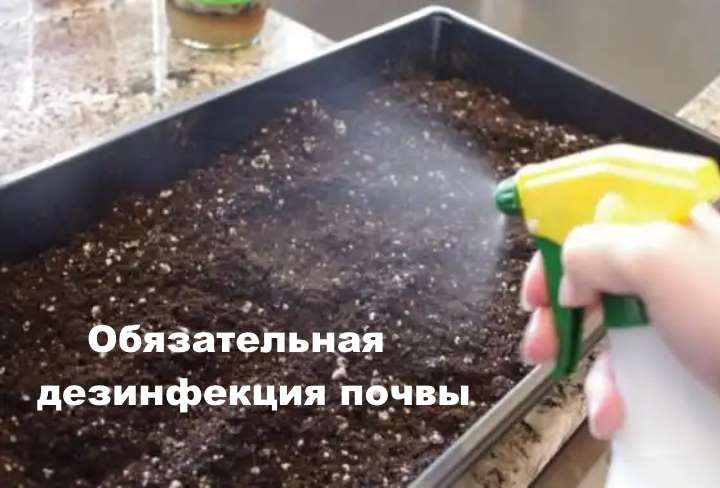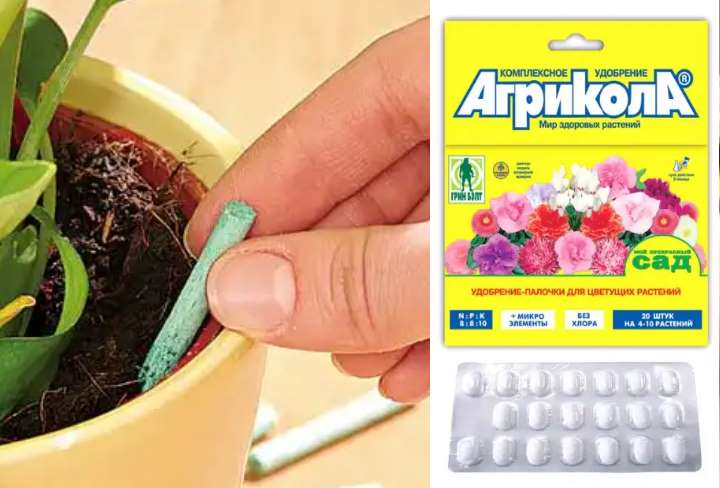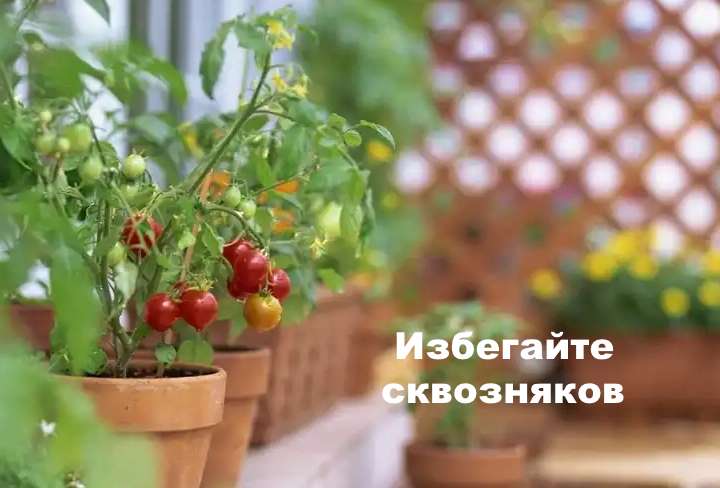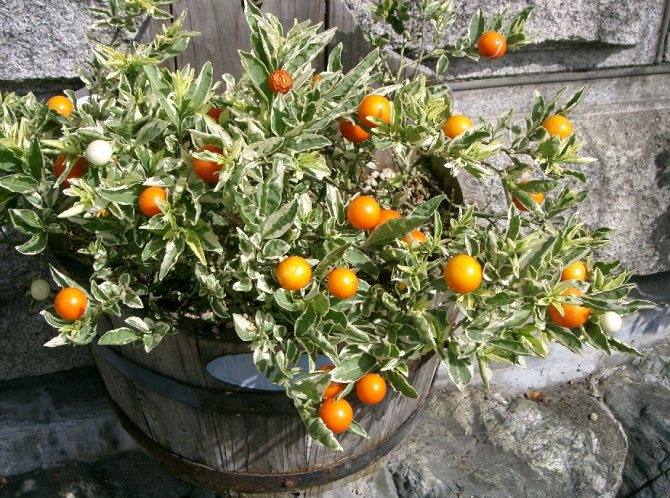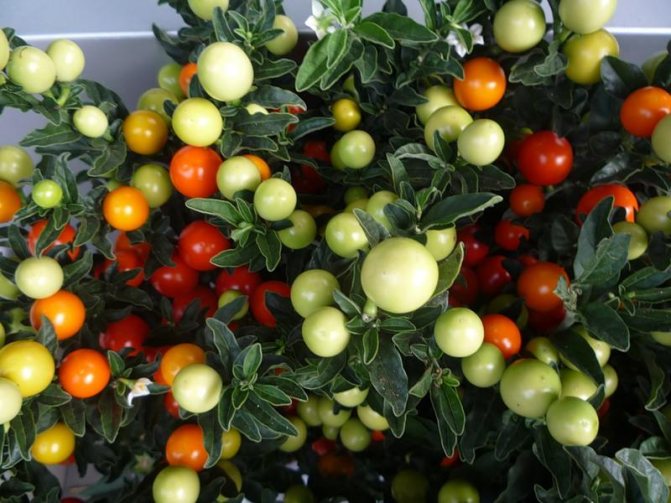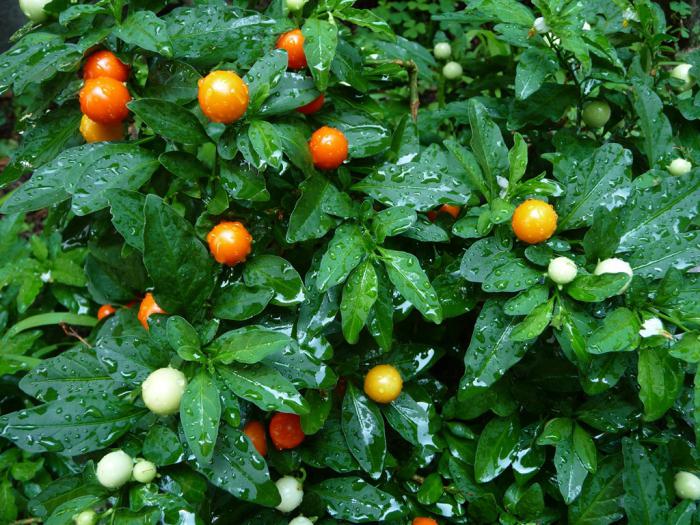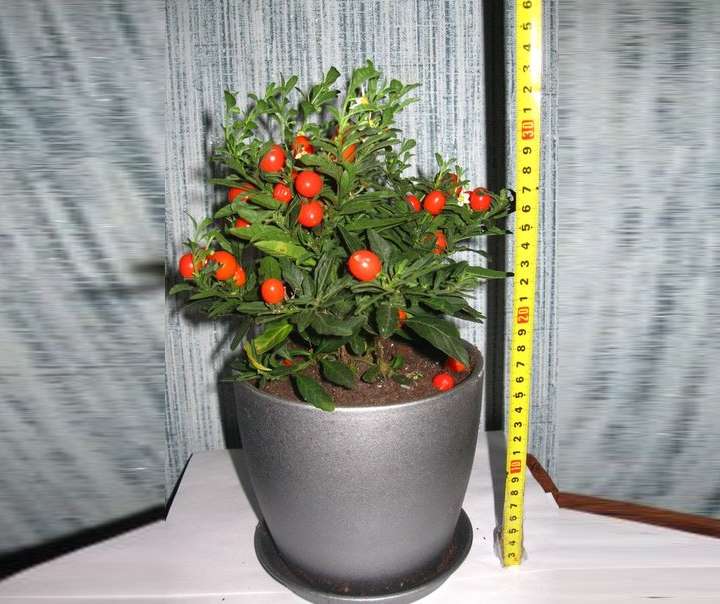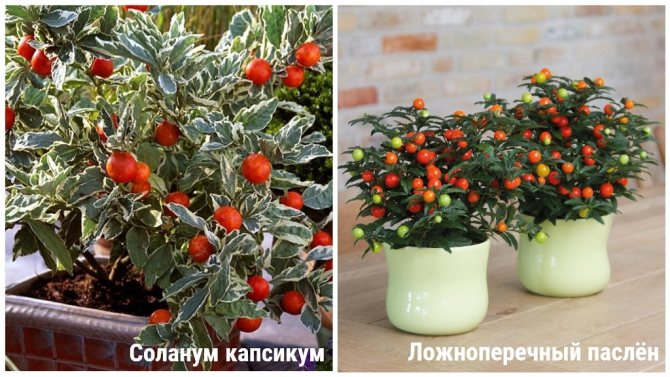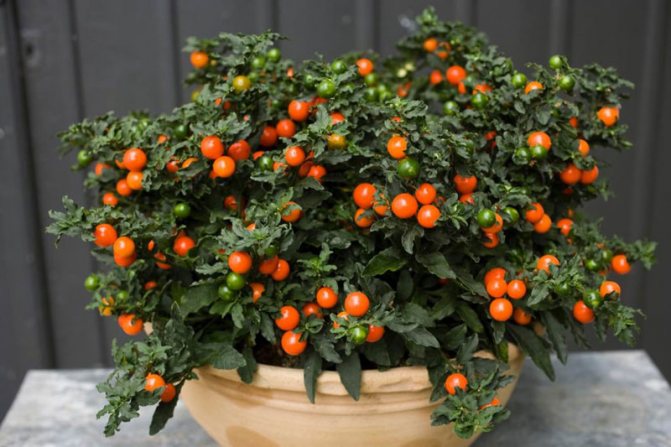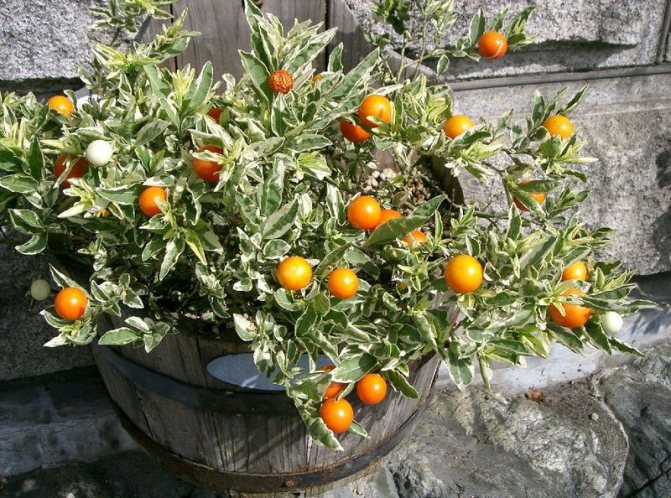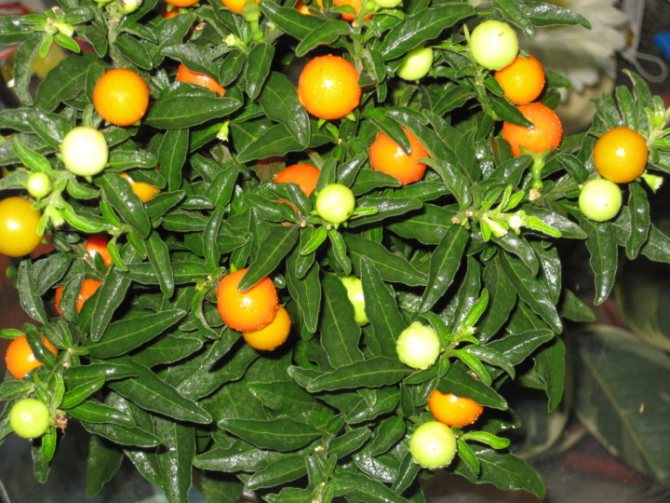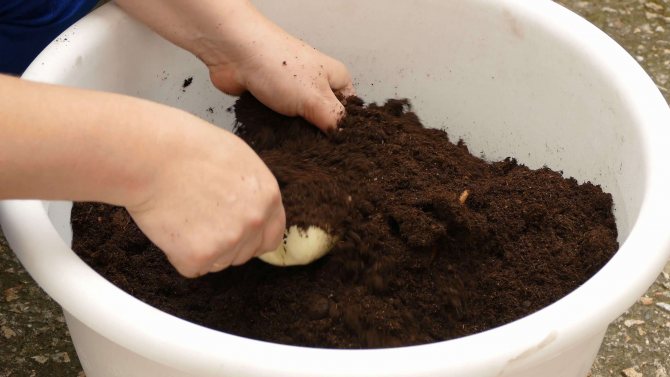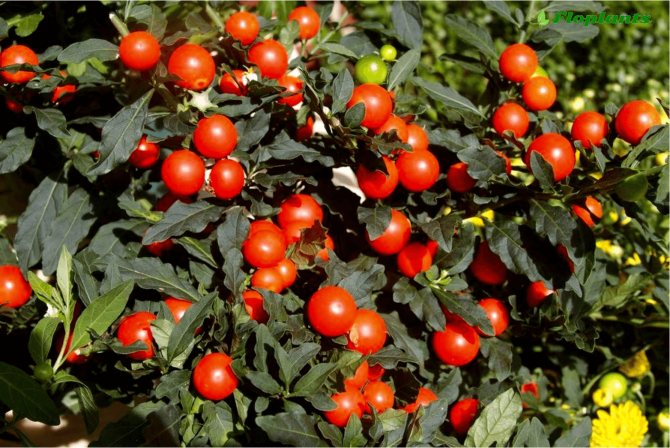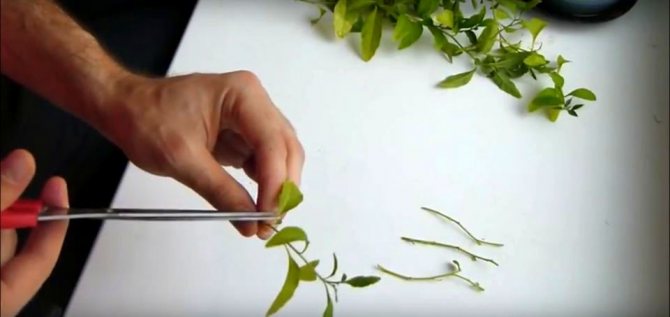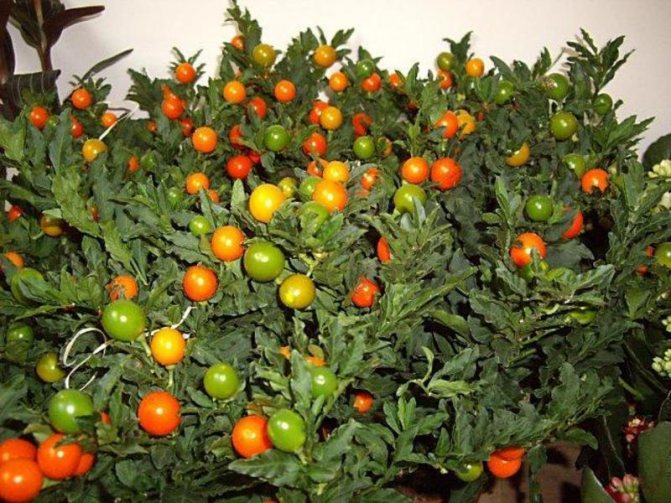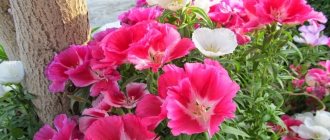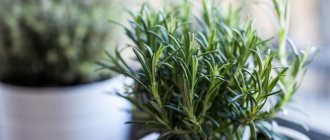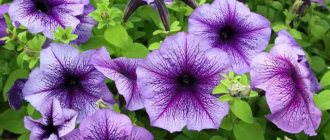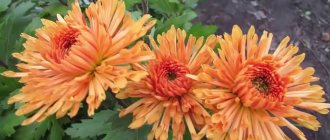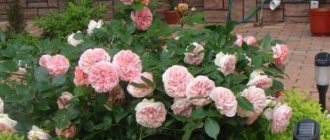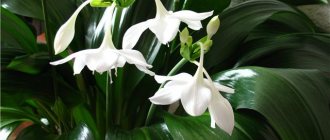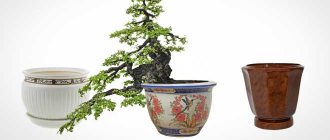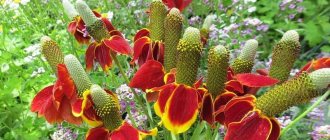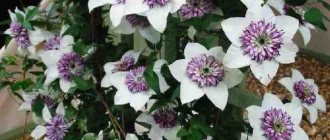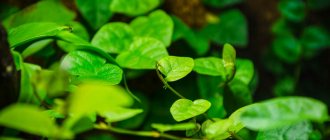Solanum is the largest plant of the genus nightshade. People often call it the indoor nightshade. Outwardly, nightshade looks like the brightest and most colorful houseplant, has red or scarlet berries that look very attractive against the background of green leaves. The flowering of Solanum begins in the summer. The flowers resemble small stars, after flowering berries appear in their place. They are green at first, but turn red over time. The nightshade has small oval leaves, reaching a length of 5 cm. The plant itself is quite large, reaching a height of 70 cm, but there are also dwarf varieties of Solanum. Often at home, there are two varieties of Solanum:
Pepper nightshade is perhaps one of the most common Solanum species. Very often it can be seen in the windows of florist shops at Christmas time. Its leaves are dark green, slightly pointed in shape. Its stems are pubescent. Flowers of pepper-shaped nightshade are small, white. After flowering, bright red berries are formed, which grow up to 1.5 cm in diameter. It is best to purchase a plant at a time when the berries are not yet ripe on it, then they are orange or green. To preserve the attractive appearance of the berries, as well as to avoid them falling off, this type of Solanum must be kept in a room with a sufficiently low air temperature. Pepper nightshade has many varieties, which may differ in the shade of the fruit and the shape of the leaves.
False pepper nightshade. This variety is mainly found in the western regions of the planet. Outwardly, it is very similar to pepper nightshade, but in fact it is not, which is why it bears the corresponding name. The stems of the false-pepper nightshade are very smooth, and the berries themselves are much larger than those of the previous type of nightshade. The leaves are also different - they are somewhat shorter.
Both species also have dwarf forms, which are half that in height.
Solanum care
Location and lighting Solanum is a plant that loves bright light very much, which means it should be kept where good lighting is characteristic. When Solanum begins to suffer from a lack of light, then it will not bear fruit and, possibly, will shed its leaves. An ideal place for a plant would be an east or west window. But during the bright afternoon sun, Solanum needs to shade. Solanum categorically does not tolerate drafts, therefore, it should be protected from the wind and avoid finding the plant in an air-conditioned room. If these conditions are observed, then Solanum will bear fruit abundantly. Watering Solanum loves moisture, therefore, during the period from April to September, the plant must be provided with abundant watering. Watering the plant should be done only if the ground is dry, do not water solanum if the soil is even slightly damp. The plant simply adores high humidity. In winter, watering of Solanum is reduced several times; distilled water must be used for watering. If the plant is watered with tap water, then it must be sure to stand for at least a day. Water temperature during irrigation should be slightly higher than room temperature. Watering with rainwater will also be useful for Solanum. At what temperature to contain solanum In the summer season, it is advisable to keep solanum in a room where the air temperature is kept from 18 to 25 degrees. From time to time, Solanum can be left in the fresh air on the balcony, but it is necessary to avoid exposure to bright sunlight and protect it from precipitation. In winter, the plant will be comfortable in a room with a temperature of 12 to 18 degrees. Drafts should be avoided in winter. At what humidity to contain solanum Air humidity directly affects whether the plant will bear fruit or not. For the appearance of fruits on Solanum, it is necessary to adhere to 65% indoor humidity. This means that the plant requires daily spraying. If you avoid daily spraying, then the pot with the plant must be placed in a pallet, after putting wet pebbles, expanded clay or peat there. Another way to maintain air humidity is artificial humidifiers in the form of fountains. Such a fountain can be placed indoors next to the plant. Pruning Solanum needs a mandatory pruning. Regular pruning will give the bush an attractive appearance. The plant is pruned to a third of the height. This event is carried out after the fruit is fully ripe. In autumn, the shoots of Solanum can simply be pinched. If you carry out regular pruning of the plant, then its shoots will grow in different directions, which looks quite ugly. Curly species of Solanum do not need mandatory pruning, and it is made at will. Dormant period As with most houseplants, the dormant period for Solanum is in the winter from November to February. At this time, the plant usually does not bloom or bear fruit. Resting watering should be reduced. It is also worth feeding the plant no more than once a month.
The original interior decoration is the solanum plant. It is not leaves, but fruits that give it decorativeness. This plant belongs to the nightshade family and looks like a bush covered with small tomatoes. Among the dense green foliage, bright orange fruits no larger than cherries sparkle. The bush grows no higher than 50-60 cm.

Solanum is more familiar to amateur flower growers under the name of nightshade, wolfberry or coral tree. He came to us from the island of Madeira, it is also common in Brazil.
Growing features
Caring for saltum at home does not require much effort. The plant is very fond of bright light and needs a long day of light. It is necessary to shade the shoots from direct sunlight only in extreme heat. For the summer, you can put the bush on the balcony or in the garden. It is important to find a warm, windless place.
The optimum temperature range for nightshade is + 18… + 20 ° C. In a hotter place, the leaves begin to turn yellow and dry. The plant does not need a dormant period.
From April to August, complex fertilizer for flowering plants is applied weekly to the soil.
To give a beautiful appearance, it is necessary to periodically prune the bush. Too elongated stems are cut in half. When lateral branches begin to develop on the remaining part, they are pinched.
Solyanum is resistant to plant diseases, but is attacked by insects. Most often, aphids, whiteflies or spider mites can be found on the leaves. It is recommended to do preventive insecticide treatment before flowering.
Solanum or false-pepper nightshade is one of 1,700 representatives of the Solanov family. This plant was brought from South America and about. Madeira is its natural habitat.
Pseudo-Pepper nightshade is a low (about 50-60 cm) shrub with a well-branched crown. The stems are covered with dark green dense leaves with a slight hairiness.The plant is of particular decorative value during the ripening of the fruits, which, as they ripen, change color from orange to hot red.
Instances suitable for indoor cultivation delight flower growers with elongated dark green leaves, white flowers and bright orange fruits.
Plant care at home
Lighting.
Solanum is a very light-loving plant. If there is little light, then this will lead to the fact that there will be few leaves on the stems, and the flower itself will not bear fruit. If possible, place the flower pot on the window on the west or east side. The nightshade should be shaded only on hot summer days to protect its leaves from "burns". The rest of the time, sunlight will only benefit the plant.
Temperature.
If the air temperature in the room where the solanum flower is located is more than 20 ° C, there is a high probability that the leaves on it will turn yellow, and the fruits will quickly "wrinkle" and fall off the stems. The optimum temperature for flower growth is up to 18 ° C.
Fertilizer.
In the summer, experienced flower growers fertilize the tree with special liquid dressings intended for ordinary indoor plants. Doing this is enough once a week. And when the plant blooms, it would be nice to treat it with an insecticide.
Watering.
During the active growth of a flower, the land where it is planted must be constantly moist. If we talk about the winter period, then the plant does not require frequent watering.
Air humidity.
In order for the nightshade to grow well, it must be regularly sprayed with water. If the air in the room is very dry, then the plant may be affected by aphids or red spider mites. To avoid the hassle of constant spraying, put the flower pot with solanum on a pallet, where pour wet pebbles, for example. This way, you can provide the nightshade with an optimal moist environment.
Transfer.
As a rule, the solanum is transplanted in February. It is during this period that the plant withers and sheds fruits and leaves. How to do it? The optimal proportions are as follows: clay soil - 2 parts, humus soil - 2 parts, leafy soil - 1 part, sand - 1 part. Provide good drainage when replanting the plant.
Circumcision.
In order for the tree to have a beautiful shape, learn how to cut it correctly. First, the main stem is cut in half. But when the active growth of lateral shoots begins, they should be pinned.
Reproduction.
Solanum flower can be propagated both by cuttings (in March) and by seeds. The seeds, as a rule, fall into the ground on their own and begin to germinate. In this case, a young flower needs to be dug up and transplanted to another place. If you decide to grow a tree from a cutting, then it is better to start planting in the spring. To create ideal conditions, the stalk is planted in sand moistened with water, and when it starts to take root, it is transplanted into the ground. When the flower reaches 15 cm in length, you can pinch it.
Solanum flower: breeding features
In order for the plant to delight you all year round, you need to transplant it every season after the leaves wither and the berries fall. The transplant substrate must be breathable, moisture-retaining, with a neutral pH. All of these factors will help the plant grow strong and healthy.
An excellent option would be soil consisting of sod land, humus, sand and peat. Each ingredient will need one part, half a part is enough sand. To feed Solanum, complex fertilizers are used for plants blooming in summer. Top dressing is carried out every week.
If the plant is still damaged, spray it with actellic solution, remove the infected leaves and flowers.
As you can see, there is nothing difficult in growing and caring for an after-plant - everything is the same as in the case of other indoor plants. If you give a flower with attention and care, it will delight you with its beauty all year round.
Solanum is also called coral bush or Cuban cherry. It is an evergreen ornamental shrub that grows up to 60 cm in height. The fruits of the plant are poisonous. They can cause stomach upset, especially in children. Therefore, if you have a small child, pet or bird, then it is better to refuse breeding Solanum.
Indoor nightshade - solanum, which is not very difficult to take care of at home, can become an original decoration of the home interior. The flower belongs to a very widespread family of about 1,700 species. Most of the representatives grow in the tropical and subtropical forests of South America, Africa and Australia. Some species are also found in the temperate zone. This family includes the well-known potatoes, tomatoes and black nightshade.
Solanumoma cultivation and home care, as well as flower photos
Solanum is quite unpretentious, but you need to know certain rules for caring for it.
Location and lighting
Solanum loves bright places. Lighting should be intense, but diffuse. On the north side, it will definitely not bear fruit. On the south side, there is a danger of direct sunlight, which can harm the plant. If this is the only place where it is possible to put a flower, then in the summer it will need to create a light shade, especially in the midday and afternoon hours.
The best place for solanum will be east or west windows. If it does not have enough light, you will immediately see this - the stem will begin to stretch, flowering will be scarce and, as a result, the plant will give less fruit, which will significantly reduce its decorative effect.
Fresh air
Solanum is picky about fresh air, it is necessary to periodically ventilate the room, and in summer you can take it outside
In summer, solanum feels very good outside. Fresh air is necessary for the plant - this stimulates its growth and abundant fruiting. It takes on a beautiful appearance. But it must be protected from the sun, rain and wind.
If the solanum is constantly in the room, it needs to provide an influx of fresh air through ventilation. But try to avoid drafts. At the time of airing, it is generally better to remove the pot with the plant from the room.
Solanum container
Basically, the plant doesn't care what material the pot is made of - ceramic, plastic or glass. In order for it to look more advantageous, you can pick up a flowerpot of bright colors - to match its fruits.
Despite the fact that the solanum transplant is done annually, the pot must be taken quite spacious. It grows quickly and root tightness can adversely affect its growth. The size of the pot can be determined by the crown of the bush - they must be the same in diameter.
Optimum temperature for the plant
Solanum does not like heat, it feels best at a temperature of 18-20 ° C. It is especially important to observe the temperature regime during the growth and flowering of the plant. In autumn, the temperature is lowered to 18 °. In winter, solanum should be kept at 10-16 ° C.
In a room that is too warm, there is a threat of spider mite infestation. In addition, the flower begins to lose leaves and fruits.
Required humidity
If the air humidity is low, the solanum will wither
The humidity indicator should not fall below 65%, otherwise it will not affect the state of the solanum in the best way. In dry air, it will simply wither away.
There are several ways to maintain the desired humidity level in the room. The easiest, hassle-free method is to make a custom tray for the solanum pot. You can fill it with peat, sphagnum, pebbles or expanded clay.The water in the pan should be constant, but not reach the drain hole in the pot. Otherwise, excess moisture will cause rotting of the lower roots. Useful for solanum and constant spraying with water. It is best done in the early morning or evening.
general description
Decorative forms of nightshade when grown indoors have the appearance of a small evergreen bush, usually not exceeding half a meter in height. Stems are erect, strongly branched when properly formed, forming a very dense, impenetrable crown. The branches are lignified, covered with dark green bark with brown shades.
This plant attracts amateur flower growers not only with its beautiful dark green leaves. It has small flowers and bright fruits, which, depending on the variety, can be red, yellow or orange. In different varieties of this plant, the fruits also differ in size. A feature of nightshade is that with proper care, the fruits stay on the bush for a long time and give it a decorative look. And since they ripen mainly in winter, you can admire the saltum at Christmas and New Year.
Color variations of the leaves are also possible. The variegated variety of False Pepper nightshade (Solanum pseudocapsicum variegatum) and Pepper nightshade (Solanum capsicastrum Link ex Schauer) are decorative. Pseudocapsicum, or False Solanum, is distinguished not only by large bright red fruits at the time of ripening and beautiful openwork leaves with a white pattern, but also by very popular dwarf forms. Pepper, or Pepper nightshade is called Jerusalem cherry for its bright dark red numerous fruits. And the leaves of artificially bred varieties of Pepper nightshade are decorated with cream spots of irregular shape. Flowers in both species are white, small, up to 1.5 cm in diameter, single. However, False Nightshade can bloom all year round, unlike Pepper, which only blooms in summer. Therefore, on the bushes of this species, you can simultaneously see both green and red ripe fruits.
There are cultivars of Solyanum with flowers that look like small white, lavender or pink bells, exuding a light, pleasant aroma. Fruits are two-celled polyspermous berries of red, black, orange or yellow colors. They can be up to 5 cm in diameter, although most domestic varieties are smaller.
Some cultivated species of solanum look like small climbing vines. In warm climates, they are used for landscaping yards and in landscape design. Wendland's curly saltwort, which is distinguished by large, star-shaped, white flowers with a slight lilac shade, decorates gazebos and fences.
Solanum breeding methods at home
Solanum can be propagated by seeds and cuttings. The seeds fall into the ground by themselves and sprout. Grown up seedlings are carefully dug up and planted in a separate pot.
You can plant the seeds yourself. This is done in early March. In a box with a prepared substrate, grains are poured at a distance of 2 cm from each other. They need to be deepened no more than 1 cm. Then the plantings are watered and covered with a film to create greenhouse conditions. The container or box is placed in a bright place. The seeds germinate rather quickly, then they need a little shade. When 3-4 leaves appear, the sprouts dive into separate pots. When a height of 12-15 cm is reached, the sprouts need to be pinched for the correct formation of the crown.
Camellia flower and home care, read more here.
A stalk can be taken when pruning a plant in early spring. It needs to be planted in wet sand. When the first roots appear, move it to a full-fledged soil of sand, humus and sod land. A sprout 15 cm high must be pinched. And at the beginning of autumn, carry out a small pruning to stimulate branching.
Types of Solyanum
The genus Solyanum is very numerous, more than 1000 species are recorded in it. The most decorative varieties are grown as indoor plants.
The plant is in the form of a tall (up to 120 cm), spreading bush retains its crown all year round. The bare, bright green stems are highly branched. Long (up to 10 cm), lanceolate leaves with a wavy edge are attached to the stem on a short petiole. Single flowers on a thin peduncle bloom from the axils of the leaves. The diameter of the white stars is 1 cm.By the middle of summer, the bush is decorated with round orange berries with a diameter of 1.5 cm.
The species is more compact. Young shoots are covered with short pubescence, while older ones are covered with dark brown rough bark. The length of the dark green leaves does not exceed 8 cm. There is a variety Solyanum capsicum variegatum with white stripes on the foliage.
The plant is a long (up to 5 m), creeping vines. There are small hooks on the petioles and stems that help the plant climb the support. The length of the leaves can reach 22 cm. On one plant, there are both single lanceolate and pinnately dissected foliage. The paniculate inflorescence consists of white star-shaped flowers with a diameter of about 5 cm. Later, orange round berries ripen on the stems, their size is 1.5-5 cm.
- an annual shrub up to 1.2 m high. Oval or ovoid leaves have a pointed edge and wavy, less often toothed sides. Small white-green flowers gather in umbellate inflorescences. Later, clusters of black berries with a diameter of 8 mm are formed on the branches. Solyanum nigrum is used in homeopathy.
It is a perennial creeping shrub up to 4 m high. Long pubescent stems gradually become lignified and bare. Oval leaves are found on most of the stems. They are painted bright green and have a shiny surface. The tips of the leaves are pointed, and the edges are covered with rounded teeth. The drooping buds are collected in a small-flowered umbrella. The petals are colored light purple or blue. Red oval or round berries reach 3 cm in diameter.
- evergreen semi-lignified shrub up to 1.5 m high. The plant is covered with oval, slightly pubescent foliage of a light green hue. During the flowering period, it is covered with small white-purple flowers. The pear-shaped fruits are yellow with purple streaks. The length of one fruit reaches 20 cm, and the weight is 400 g.
Problems when growing solanum at home
If solanum blooms but there are no berries after that, this means that there is not enough pollination
When growing solanum, the following problems may arise:
- Few berries and they are not tied. This means that the plant needs pollination. During flowering, you need to transfer pollen from one flower to another using a soft brush.
- Leaves and fruits are showered. This can happen when the indoor air is too dry, especially in winter, when the central heating is on. Increase the humidity in the room.
- Pest infestation, in particular, spider mites. This happens if the room temperature is too high and the air is dry.
Diseases, pests and care of the solanum plant in this season
If the rules for watering are violated, solanum may suffer from root rot. Its crown is beginning to shrink. In this case, the plant must be removed from the pot. This is not difficult to do, since the substrate will be moist. Examine the roots - they are soft to the touch and have an unpleasant odor. You need to get rid of such a plant, because it is already impossible to save it. Carefully disinfect the pot from under the diseased plant.
Of the pests, the danger to solanum is spider mites, aphids and whiteflies. In the summer, they can get into the room when ventilated. They are disposed of with insecticides.
From fungal diseases, solanum can be affected by late blight and "black leg".At the very beginning of the disease, treatment with foundation can help. In an advanced stage, the plant will have to be thrown away.
Diseases and pests
From fungal diseases, in addition to root rot, solanum can be affected by late blight and "black leg". If you treat the plant and soil at the very beginning of the disease with Fundazol, then the flower can be saved.
In conditions of too dry and hot air near the radiators, the plant may crumble fruits and turn yellow leaves. In this case, it is advisable to rearrange the pot with a bush away from heating devices and increase the air humidity.
In indoor conditions, even with a large number of flowers, few fruits can form. This is due to a lack of pollination. Artificial can be done with a soft brush or simply by rubbing nearby flowers against each other.
According to Feng Shui, it is considered very favorable for the home if the houseplant has a spherical shape. A properly formed crown of Solyanum will help stabilize the energy field in the room where it is located. Superstitions associated with the Chinese cherry (ornamental nightshade) claim that this plant attracts a large amount of positive energy into the house. In any case, original bushes with bright fruits will revive any home interior. But it is worth remembering that you need to be careful when growing this flower, since all its parts are poisonous.
The original interior decoration is the solanum plant. It is not leaves, but fruits that give it decorativeness. This plant belongs to the nightshade family and looks like a bush covered with small tomatoes. Among the dense green foliage, bright orange fruits no larger than cherries sparkle. The bush grows no higher than 50-60 cm.
Solanum is more familiar to amateur flower growers under the name of nightshade, wolfberry or coral tree. He came to us from the island of Madeira, it is also common in Brazil.
Benefit and harm
Unripe solanum berries are poisonous, they cause severe stomach upset, so care must be taken to grow it in a home where there are small children and pets. If you cannot deny yourself the pleasure of keeping this beauty in the house, place the flower out of the reach of the child. It is not recommended to keep solanum in the bedroom, especially in the nursery.
However, ripe fruits and young green stems can be beneficial. Cut dried tops of the plant are infused with alcohol and used for colds, asthma and eczema. As an external medicine, it is used to treat wounds and abscesses. As part of sedative mixtures, it helps to cope with depression. However, all is well in moderation, the abuse of such drugs can be fraught with poisoning.
Decorating the interior with greenery is a fascinating and enjoyable experience. Now more and more people prefer to settle in their exotic species. Solanum, a tropical member of the nightshade family, has gained popularity. He came to our latitudes from Brazil and the island of Madeira. What is it, how to care for it and reproduce it?
Is indoor solanum dangerous for life?
Regardless of the place of disembarkation, be it an open area or a pot, it is necessary to provide safety measures related to the poisonous qualities of the Solanum flower.
If any part of the plant enters the stomach, disruption of the gastrointestinal tract is noted, and even poisoning. Therefore, flower growers do not recommend people with small children or animals to acquire this culture.
Solanin performs in nature the function of a plant protector from pests. This component is a dangerous toxin and, if ingested, may affect the development of the fetus in a pregnant woman.
The plant is especially dangerous for dogs and other pets. An organic toxic chemical compound in a miniscule dose can lead to the death of animals.
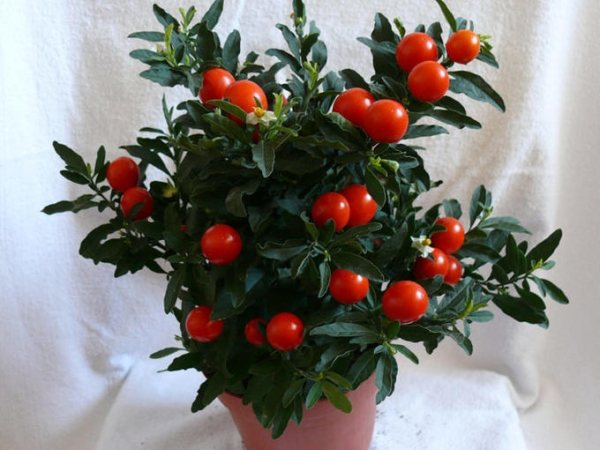

All parts of the shrub contain solanine, are poisonous to animals and humans
What is remarkable, the description
Solanum is one of the largest representatives of the Solanaceae genus. His appearance is attractive, extraordinary and bright. It is a juicy green bush with thin twigs. Oval alternate leaves are very densely located.
The root system of an evergreen perennial is superficial. The height of the bush is from 40 to 70 cm, rarely up to 120 cm. Dwarf varieties are in great demand, which are convenient to keep in small rooms. These do not grow to more than 30 cm. The most common varieties are jasmine, pseudo-pepper and pepper solanum.
The houseplant blooms in early summer or late spring. Umbellate or paniculate inflorescences appear on the solanum. Small flowers can be pink, white and blue. A pleasant, unobtrusive aroma emanates from the inflorescences. After flowering, there is a short period of rest, and only then the ovaries are formed.
Solanum, the fruit of which is a real decoration, looks very colorful. The plant has round berries of yellow, orange, red or almost black tones. The diameter of each is about 5 cm.
The fruits have one feature - poisonousness. This applies to all varieties and varieties. Therefore, be careful and place the pot out of the reach of children and animals.
Description of the plant
Solanum solanum is an evergreen perennial in the form of a spreading bush or miniature tree. The rhizome is highly branched. But it is mainly on the surface. Plant height ranges from 45-120 cm. Erect, highly branched stems form a very dense, impenetrable crown. The branches quickly become lignified and covered with dark green bark with brown shades.
Oval leaves are arranged alternately on the shoots. They have a glossy surface and a wavy side edge. A pattern of veins is clearly visible on a dark green leaf. The length of the leaf does not exceed 5-10 cm, and the width is 2-5 cm.
Flowering occurs in summer. At the ends of the apical and lateral shoots, loose paniculate or umbellate inflorescences bloom. Small bell-shaped buds of white, lavender or pink flowers exude a light, pleasant aroma. Each bud has its own elongated peduncle. The flower diameter is 1-3 cm.
Later, round berries ripen in place of flowers. The juicy pulp contains many small whitish seeds. The skin of the fruit is quite elastic. It comes in red, black, orange or yellow. The berries remain on the bush for a long time and increase its decorative effect. They can reach 5 cm in diameter, although they are often more modest in size. Salt flower is very dangerous. In no case should you eat fruits. They are very poisonous and can cause severe food poisoning.
We create optimal growing conditions
In order for the plant to grow and develop safely, it is necessary to provide optimal conditions. There are several important aspects to watch out for.
Solanum is a light-loving flower. For him, the ideal place in the house is a southern or southeastern window sill. On the server side, flowering is poor and short-lived. The location of the pot in the back of the apartment causes the plant to shed its leaves. In the heat, it is advisable to protect the greens from direct active rays.
Temperature
The flower is characterized by periods of vegetation and rest. In summer, the ideal temperature regime is 23-25 ° C. In winter, you must choose a room with a temperature of 13-15 ° C.
Humidity
The bush is very demanding and sensitive to air humidity, because it is a native of the tropics. The flower perfectly accepts frequent spraying. The ideal time for the procedure is early morning and late evening. As a result, gas exchange and respiration are improved. Some growers place wet sphagnum moss in a pot or near a flowerpot.In dry air, the flower withers and loses its berries.
Flower transplant
The nightshade should be replanted in the spring, this is done along with pruning. Usually, manipulations are carried out in February. A substrate with a high degree of air permeability is used. A moisture-retaining soil with a neutral pH and good aeration is ideal.
Correct soil
will promote the healthy growth of the home shrub.
At the same time, the stems are immediately cut off by almost half. First, the large stem is shortened, and then the ends of the shoots are pinched when they begin to grow. This method will ensure the formation of the correct and beautiful shape of an exotic tree.
Do I need a transplant after purchase
Periodically, the plant needs a pot change and soil renewal. Regarding the solanum flower, a transplant after purchase is not always necessary.
If the owner sees that the plant is developing normally and bearing fruit, it is better not to disturb him.
Over time, the container becomes cramped for overgrown roots. The next flowerpot is chosen with a diameter of a couple of cm more. A planned transplant is best done in early spring after pruning. Experts recommend shortening the flower before transplanting ..
Prepare fresh soil first. To do this, mix two parts of clay and humus, one part of clay and sand. The transplant is carried out carefully, trying not to damage the rhizome. Then provide abundant watering.
Some owners prefer to plant a flower in the open ground for the summer. In the fall, the plant must be returned to the room.
Types of Solanum
It is an indoor perennial plant belonging to the nightshade family. It is an evergreen deciduous shrub with a height of just over half a meter. The homeland of nightshade is the South American coast. The exotic look of the shrub is given by its elongated glossy leaves and branches constantly showered with berries and flowers. Bright orange and red fruits
resemble cherries, hence the popular name.
Bright and attractive berries, alluring from afar, are the plant's natural defenses. They are poisonous, so you should not try them on the tooth, even for the sake of curiosity.
And this fact must be taken into account if there are small children or pets among the household.
In nature, there are more than 1,500 species of nightshade. In our area, at home, you can find only a few.
Pepper nightshade
The view is more compact in size. It differs in smaller fruits and delicate shoots. This shrub is from the South Brasil and Uruguayan forests. The people received the glory of the "sore throat"
, since a healing infusion is made from its shoots.
False Nightshade
Shrub up to 1.2 meters high with oval leaves and white small flowers. It bears fruit with round red or yellow berries. At home, a stunted form of nightshade takes root. This species has its roots in the island of Madeira.
Both varieties of solanum are adapted to domestic conditions, but some of them are very demanding.
Features of care in summer and winter
Solanum is characterized by a pronounced period of winter dormancy. Therefore, care in summer and winter is different.
What to do in spring and summer
Spring is the best time for pruning and replanting.
During this period, the plant needs intensive watering. The higher the temperature, the more often the water should be added. Make sure that there is no waterlogging in the flowerpot.
On warm days, remove the pot to fresh air whenever possible. This will ensure abundant flowering.
Top dressing is carried out every 1-2 weeks. Liquid complexes of mineral fertilizers are suitable.
If it is hot and the air is dry, spraying is carried out daily. A container with water is placed next to the pot.
What to do in autumn and winter
In autumn, the intensity of watering and the frequency of fertilizing are gradually reduced.Before the cold comes, take the flowerpot out to the terrace at least once a week.
In winter, top dressing is applied once a month. The temperature should not be lower than + 5 ° C. Cold has a bad effect on the flower.
For winter, choose a cool room with plenty of light and high humidity (60%).
How to care for a flower
Although this plant is not a capricious one, some nuances should be taken into account when caring for it. Like many other members of this family, nightshade fruits are poisonous. Solanum berries can be poisonous, as if they enter the stomach, they cause a dangerous digestive upset. Therefore, when choosing a place for a plant, it is worth considering this, especially for those who have small children and pets.
The plant is well adapted to domestic conditions, but for optimal care of indoor nightshade, conditions should be created for its natural growth, that is, a microclimate corresponding to the conditions of a tropical or subtropical forest. Since the solyanum flower is a representative of the flora, it needs a long day of light and a bright, but diffused light. Delicate thin leaves can be damaged by direct sunlight. Therefore, in the room, it is preferable for him to allocate space on the eastern or western window sills. If solanum is placed on a southern windowsill, then in the summer months it will need to be created for it a slight darkening from thick tulle or white paper. On the north side, this plant may lack light. In this case, there will be few leaves and fruits on it.
The optimum temperature for growing a coral bush (also called solanum) is 18-25 degrees. If the temperature is too high for the plant, then the leaves may turn yellow and the fruits fall off. It is very useful to keep nightshade outdoors during the summer months. This has a very beneficial effect on the general condition of the plant and contributes to more abundant flowering and fruiting. In the autumn-winter period, a cool temperature of 12 to 15 degrees will contribute to a longer time spent on the branches.
In the warm season, this plant needs abundant regular watering and spraying. As a resident of the tropics, he needs high humidity. Therefore, it is recommended to put a pot of solanum in a tray with expanded clay or small stones that need to be moistened periodically. However, excess moisture in a pot with poor drainage can lead to soil acidification and root rot. It is advisable to water these decorative bushes with warm, settled water only after the top layer of soil in the pot dries up. The root system of nightshade is developed, but superficial, so wide, but not very deep pots are suitable for him.
Pruning rules
Pruning will keep the shrub flowering and looking neat. The procedure must be done every year, or even twice. If you plan to transplant in the spring, the plant must be pre-pruned.
Spring is the perfect time for formative pruning. After all, the crown grows quickly and looks untidy over time. Most often, the bush is given a spherical shape. On such a flower, bright fruits look very attractive. Shoots are shortened by a third.
If you want to get a standard tree, use the following recommendation. Several young plants are planted in a pot. Next, the lower shoots are trimmed so that the trunk is bare at the bottom. The lower parts of the flower are carefully twisted. Crohn is given the desired shape or left to grow at random. The solanum formed in this way looks very beautiful.
Top dressing and pruning
During the period of intensive growth, flowering and fruiting, the plant needs regular feeding with a complex of mineral and organic fertilizers. Usually, in warm weather, it is fed with liquid fertilizer once a week, in winter - once a month.
To form a beautiful crown, the solanum flower needs annual pruning and pinching of young shoots. Pruning is usually carried out before transplanting during the resting period of the plant, when all the fruits are ripe and have fallen off. The trunk is shortened by about one third, giving the crown a compact appearance. During the period of intensive growth, the twigs are pinched. This promotes the formation of side shoots.
It is best to transplant shrubs in February. For this, a pot of slightly larger capacity and soil are taken, which consists of 2 parts of clay soil, 2 parts of humus soil, 1 part of leafy soil and 1 part of sand. Do not forget about the drainage layer when transplanting.
As for reproduction, new nightshade bushes can be obtained by germinating its seeds, or by cuttings. Often, fruits that have fallen into the ground germinate on their own, forming new plants. They are planted in separate pots. Seeds are harvested from fully ripe fruits. In March-April, they are sown in a shallow container directly on the surface of the soil and lightly sprinkled. The container is covered with glass or transparent film. After about 2 weeks, the first shoots appear. The container is no longer closed. Young plants of solanum are grown at 22-25 degrees Celsius. To stimulate branching, young twigs are pinched several times during the summer. You can propagate nightshade by cuttings in spring and summer. For this, twigs 10-15 cm long are cut from the mother plant and placed in a moist substrate consisting of equal parts of sand and peat. The cuttings root quite well. After the start of growth and the appearance of new leaves, young plants are planted in separate pots.
What difficulties do flower growers face?
In the process of growing a plant, the owner sometimes encounters some difficulties.
Lack of fruit
If your flower is not producing fruit, most likely pollination has not occurred. Next time, do it yourself with a soft brush. Or shake the plant several times.
Leaves fall or fruits fall prematurely
The solanum may be lacking moisture. This often happens in extreme heat or when the batteries are running. Provide a level of at least 60%. The problem is also caused by a lack of light.
The appearance of pests
The plant is capable of infecting standard plant parasites - aphids, spider mites, whiteflies. Examine the flower carefully. If pests are found, immediately treat with appropriate insecticides.
Reproduction methods
Nightshade is propagated either by seeds or cuttings. The first way is more efficient. Seed reproduction
immediately gives strong shoots. But a shrub grown from a cuttings will need an adaptation period to fix in a new soil.
Sowing is recommended to start in March. And it will be successful only if the temperature regime of the soil is observed - 18 ° C. The seeds are sown at a distance of 20 mm to a depth of one cm. Seedlings appear in 10 days and they need another week to gain strength. Only after that they are planted in separate containers. It is better to pinch the seedlings a couple of times, which will improve the branching process.
Larger species of nightshade after all propagated by cuttings
... They need a lot of moisture and warm soil (20 ° C) to take root. Cuttings are cut during spring pruning and immediately take root in the substrate.
Propagation by cuttings and seeds
If you have solanum, propagation can be done in two ways - by seeds and cuttings.
Sowing seeds
If sowing some plants is a rather difficult and long-term event, then, as a rule, there are no problems with solanum. Most flower growers prefer this method.
The seeds are planted in the soil in the spring. They prefer well-drained soil, which is thoroughly moistened beforehand. After planting, the container is covered with foil. The temperature is maintained at 20-22 ° C.After the sprouts appear, the solanums are planted in separate pots.
Planting cuttings
A stalk with several leaves is cut from the plant and placed in water. After root formation, the young flower is ready to be planted in the soil. Freshly cut cuttings are also planted. If this is the case, water them frequently and abundantly.
A bright lush solanum bush will decorate any home. Anyone who puts a flower at home will have a lot of pleasure. However, in order for him to feel good and develop, you will have to make some efforts. Pay attention to indoor humidity, temperature conditions and lighting. Otherwise, caring for a flower will not take much time.
Let's watch a video on how to care for a solanum plant:
Reproduction
Solyanum is propagated by sowing seeds or rooting cuttings. The procedure can be carried out at any time of the year, but the March crops will develop the fastest. A box with sandy-peat soil is prepared for planting. Seeds are evenly distributed in the holes at a depth of 1-1.5 cm. The container is kept at a temperature of + 15 ... + 18 ° C. Solyanum germinates within 10-14 days. When 3-4 true leaves are formed on the seedlings, they are dived into separate pots. To form a sprawling bush, the stems must be pinched periodically.
To root the cuttings, cut apical, semi-lignified shoots with 4-5 leaves 8-12 cm long. You can root them in water or in moist soil. Cover the seedlings with a cap to prevent moisture loss. The process takes 2-3 weeks. At the age of 1 month, they can be transplanted into separate pots.
Conditions of detention
It is not difficult to grow a plant that pleases with long flowering and decorative fruits - it is enough to create conditions close to the climate of warm countries, and take care of it in a timely manner.
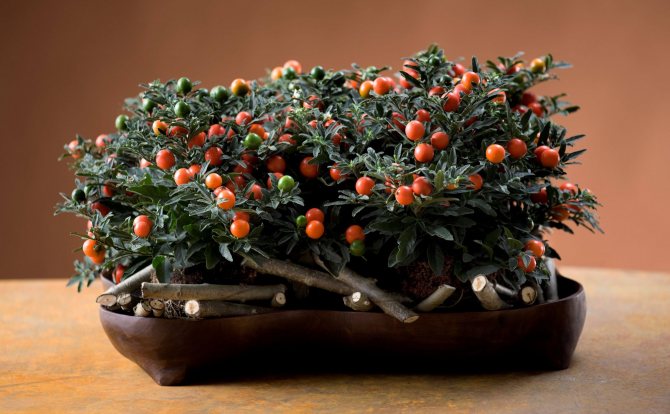

Solanum in a flat pot
Location and lighting
Bright, diffused light is best for a houseplant. They do not place pots on the northern windows of the apartment, but the southern window sill in the summer heat is poorly adapted for solanum. On hot days, direct sunlight causes leaf burns - the bush must be shaded. It is undesirable to remove the flower inside the room; it does not tolerate frequent changes of places.
In the warm season, the pot with the plant is taken out on balconies or loggias, placed in the garden, but always in places protected from drafts, north wind, direct rays of the sun.
Substrate and container size
Choosing a container for planting, they are guided by the rapid growth of green mass by the plant. The roots should be free in the ground. This is due to the fact that solanum acquires the greatest decorative effect during the fruiting period, which requires a lot of nutrients delivered from the ground.
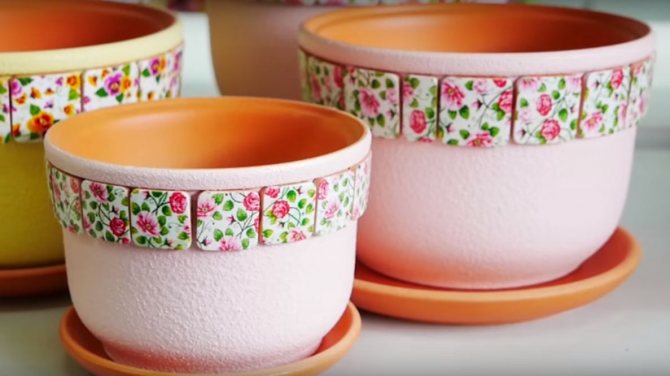

Flower pots for planting solanum
The pot should not be much smaller than the crown in diameter. This will prevent the container from tipping over during the stormy vegetation.
It is recommended to plant a flower in light soil that allows air to pass through and retains moisture. For city dwellers, the option of buying a ready-made substrate can be considered optimal.
Summer residents can prepare the soil on their own by mixing garden soil, compost, sand and peat in equal proportions. For 10 liters of the mixture add 15-20 g of complex mineral fertilizer.
Both store-bought soil and homemade substrate must be disinfected for signs of fungal infections or mold. A water bath for 40 minutes, 15 minutes of frying in the oven or abundant watering with a pink solution of potassium permanganate will do.
A solution of potassium permanganate should have a rich color - pale pink solutions, as many online publications advise, will not be useful.
A soil pH of 5.5 to 7 pH units is considered the best for growing solanum.
Temperature and humidity
Warm in summer and cool in winter - this is how the temperature regime for indoor solanum is characterized.
During the active growing season, a place with a regime of 18-25 ° C is chosen.Higher temperatures will lead to yellowing and leaf fall. Parameters below comfortable ones will cause problems with the formation of fruits, because of which the plant is grown.
In winter, the temperature is considered optimal from 12-13 to 15-18 ° С. Below these values, the likelihood of disease increases. Exceeding the norm will affect the appearance of the plant - the leaves will turn yellow, some of them will fall off.
Humidity within 65% is the best for the development of nightshade. In winter, when the heating is turned on, the humidity is artificially increased by spraying the air around the bush, or by placing a bowl of water next to the flower. In summer, spraying is carried out twice a day: early in the morning and at sunset.
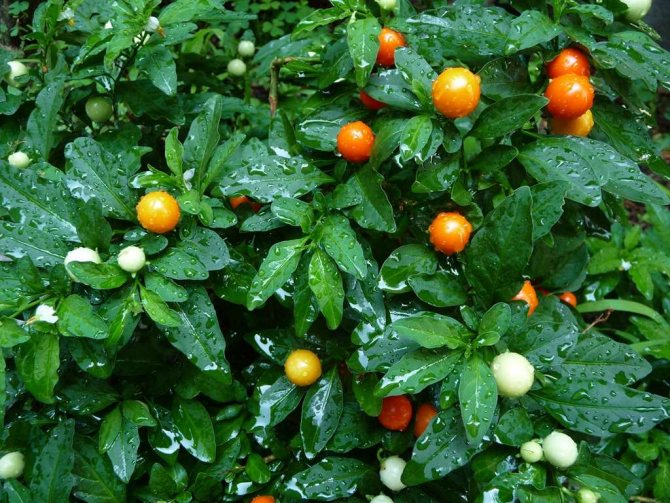

Solanum after spraying with water
Necessary watering
Properly selected soil should retain water, but not lead to its stagnation. In summer, the flower is watered as the top layer dries. Better to do it daily. So that excess moisture does not lead to the development of rot, a drainage layer must be placed at the bottom of the pot.
In autumn and winter, watering is gradually reduced to once a week, as in the summer, focusing on the state of the topsoil.
Fertilizers
Top dressing has a positive effect on the number of fruit set and the overall phenotype of the flower. During the growing season and fruiting, nutrient mixtures are added twice a month; in winter, one feeding per month is enough.
Use liquid complexes for flowering plants or even mixtures for tomatoes.
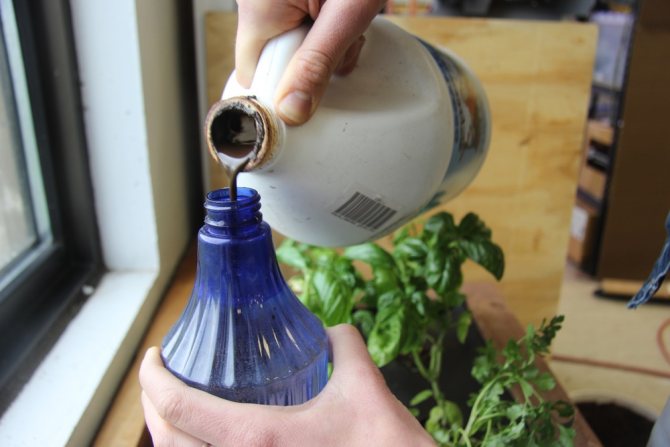

Prepare feeding solution
Pruning
They begin to form the crown six months after planting.
The algorithm is simple:
- Pinch young twigs immediately after the second bud.
- After the lateral shoots have grown to 10-15 cm, they are also pinched, leaving two buds on the stem.
- After "harvesting" the entire bush is shortened by cutting off each side shoot by a third.
- In the spring of next year, the final formation of a bush of the desired shape is carried out.
The popular types of crown are considered to be a ball or a standard tree - it all depends on the preferences of the grower. As the lower part of the stems is exposed, they are twisted together, preserving the attractive appearance of the bush.
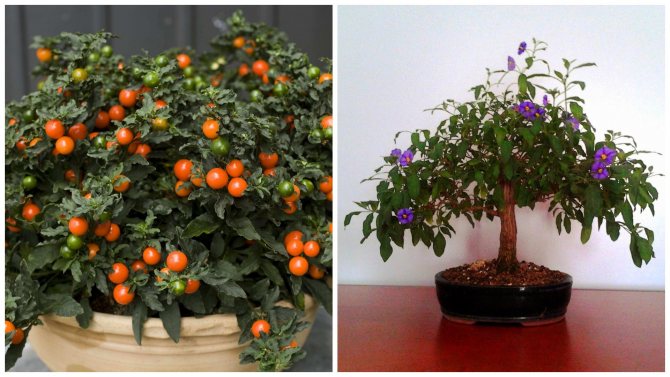

Types of crown formation of solanum
Winter period
In winter, solanum begins a period of rest, they prepare for it - they reduce the abundance and frequency of watering, less often fertilize is applied. They choose the coolest room in the apartment for wintering. A temperature of 10 to 15 degrees will only benefit the plant.
Growing solanum from seeds
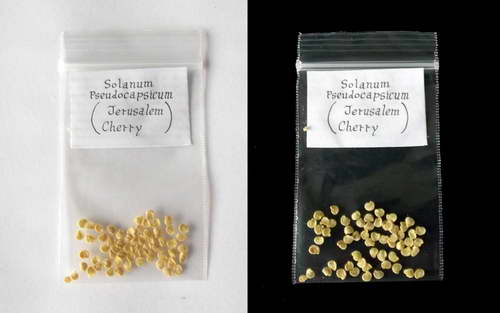

Seeds of solanum pseudocapsicum photo
Difficulties during growing
Solanum has a weak immunity to most ailments that affect plant crops, insects harm it. The risk of disease increases if the plant is poorly cared for.
Diseases and pests
Among insects, the whitefly is a particular danger. Favorable conditions for its reproduction are:
- poor ventilation of the culture;
- mass accumulation of plants.
For the fight, special traps and chemical reagents are used. Spraying with sweetened warm water (2 tablespoons sugar per glass of water) helps.
Of the ailments, solanum is most often affected by diseases:
- root system - late blight;
- stem - black leg;
- leaflets - spider mites, aphids.
Each ailment is treated with its own methods: the affected areas are cut off, disinfected, treated with chemicals, washed with soapy water.
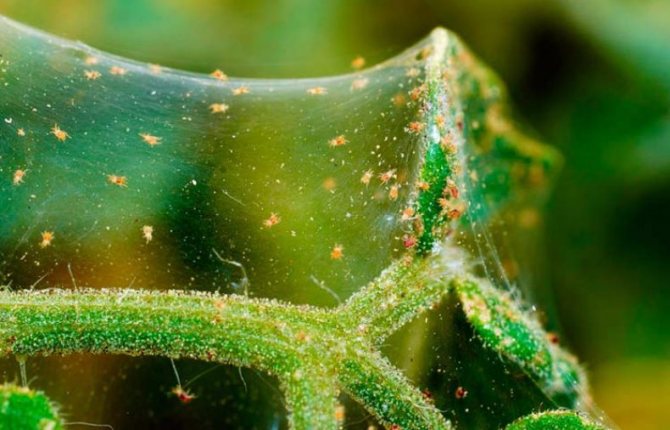

Spider mite is one of the most dangerous plant pests
Botanical Description of False Nightshade
As an ornamental plant, False-Pepper nightshade (Latin Solanum pseudocapsicum) is grown. It is a semi-shrub with a height of 30 cm-1.8 m, when grown indoors it is limited to a height of 60 cm. The long winding stems of the plant are densely covered with leaves. Ovate leaf plates with pointed tops, dark green in color.
Flowers, like potatoes: regular shape with a double perianth, five stamens and one pistil, narrow anthers, fused around the column into a conical tube. Most often, the flowers are white, they can be bluish in color. Fruits are ellipsoidal berries about 1 cm long, they are shiny, green color, as it ripens, is replaced by yellow, orange, red.
Solanum is incredibly hardy, even an inexperienced florist can handle the cultivation and care. Create favorable conditions by watering, periodically feeding the plant and pruning.
A decorative tomato will decorate a house, apartment, office, any institution with dark green leaves and a scattering of bright berries. An unusual and bright bush fills the space with light, charges with a positive, and fertility and unpretentiousness add to it pluses.
In the natural environment, false-pepper nightshade is widespread in South America; it can be found all over the world with a warm climate. Prefers places along the banks of reservoirs, in damp meadows, in thickets of bushes.
When solanum blooms and bears fruit
Solanum bloom begins in spring or summer (May-August). Then the fruits are tied, if there are few of them, pollination did not occur (next time the plant needs to be helped by cross-pollination).
Solanum pseudocapsicum: is it possible to eat the fruit?
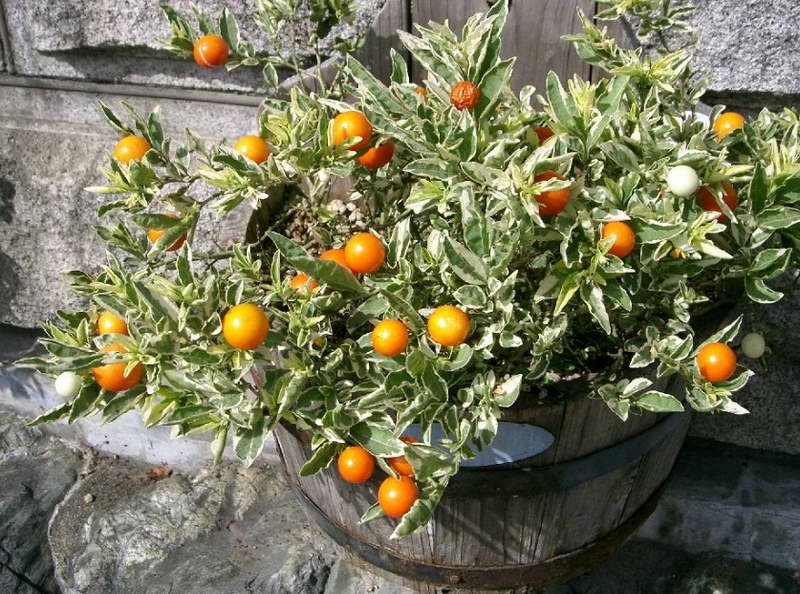

Solanum berries are edible?
The external attractiveness of the fruits of pseudo-pepper solanum is deceiving. The berries are saturated with a toxic substance glycoalkaloid solanine. Eating solanum fruits leads to indigestion. This is especially dangerous for children and pets, so their access to the plant should be limited. It should be noted that among the representatives of the genus there are plants with edible fruits - black nightshade, sunberry, pepino, naranhinya or Kito nightshade, cocoon.
Solanum orange: are the leaves poisonous or not?
The rest of the pseudo-pepper solanum is also poisonous, so avoid getting the juice on the mucous membrane and skin. Wear gloves to work with the plant, and then wash your hands thoroughly.
Useful properties of pseudocaspicum solanum
Ripe nightshade berries are used in folk medicine to treat sore throat. Leaves and stems are insecticidal. Their broth (take 5-6 kg of fresh raw materials for 10 liters of water) is sprayed on plants against aphids and other pests.
Is nightshade dangerous
The pseudocapsicum saltum flower has poisonous properties, therefore, certain safety measures must be observed.
Read also: To plant and forget: how to grow young in a summer cottage
In nature, solanine (a toxin that is part of the plant) performs a protective function, saving it from pests. It is not recommended to grow a flower in a house with small children: the fruits of solanum look so attractive that a child will definitely want to try them.
When a pregnant woman enters the body, the poison of the plant has a negative effect on the development of the fetus. The toxin is especially dangerous for pets., because even in a small dose, it can cause the death of an animal.
A poison that has entered the gastrointestinal tract of a person or animal causes disruption of the digestive system, and sometimes severe poisoning. If certain maintenance rules are not followed, the solyanum flower is very dangerous.
The decorative Solanum flower looks great in all seasons and is able to decorate any interior. However, before purchasing a plant and starting to grow it, each grower needs to familiarize himself with the basic rules of maintenance and know how to care for a flower.
Top dressing
Top dressing is carried out every 2 weeks with universal fertilizers intended for deciduous indoor crops. You can use fertilizers for tomatoes, as they are members of the same family. The plant blooms and bears fruit for a long period, and for its normal state a full set of nutrients is needed so that it does not stagnate and does not hurt.
They begin to intensively feed the nightshade in April, when it is actively growing and flowering begins by the beginning of summer. Accepts Agricola feeding well, but other options can be used. In winter, it is enough to apply liquid fertilizers once a month.
Propagation of nightshade by cuttings
With seed reproduction, flowering and fruiting of solanum begins a little later. At home, solanum is more often propagated by cuttings. The procedure is best carried out in the spring, especially since a lot of material remains after the spring pruning.
- The length of the cutting should be about 10 cm, make the upper cut straight, and the lower cut at an acute angle.
- Cuttings are recommended to be rooted in water, pre-hold the cutting in a growth stimulant solution (Epin, Kornevin, Zircon).
- The roots will appear after a couple of weeks. Then we plant the cuttings in separate containers with a suitable substrate.
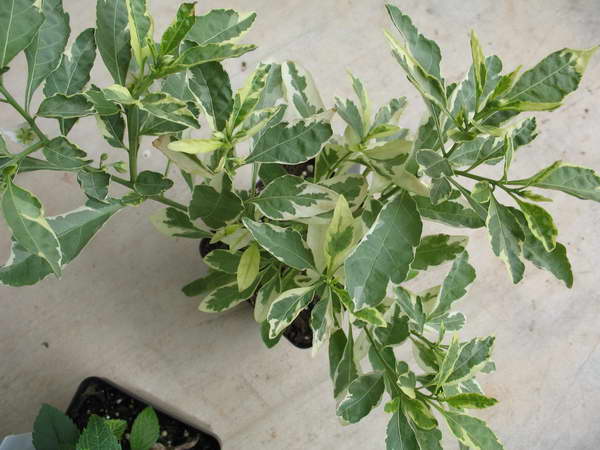

Propagation of solanum by cuttings photo of rooted cuttings
- It is advisable to hold young plants under a glass jar or a cut plastic bottle for the first 7 days. Remember to raise the shelter daily for ventilation.
Real viruses
There are several diseases in the modern world. People who get them are somewhat zombie-like:
- Toxoplasmosis is a disease that is transmitted from cats. Many studies that have been carried out on rats have shown that infected with this virus, they begin to eat themselves. This disease actually affects half of the world. People with strong immune systems do not notice any symptoms, but those whose immune systems are weakened do notice outbursts of anger and auto-aggression. Although toxoplasmosis to date has not turned anyone into a zombie.
- Creutzfeldt-Jakob disease is a disease of the cerebral cortex and neural nodes, which is dystrophic in nature. The human brain is damaged, hallucinations begin, dementia, loss of skills, inadequate thinking, rage appear. There is no cure for this disease, it can be hereditary and acquired. But this disease is unlikely to lead to a zombie apocalypse, since a person with such a disease dies within two years.
- African trypanosomiasis occurs when a tsetse fly bites. The disease affects the central nervous system, there are bouts of hunger, accompanied by fatigue and lethargy. Perhaps this disease has created the image of a zombie among African peoples. But this disease is completely curable and will not lead to the apocalypse.
Plant pests
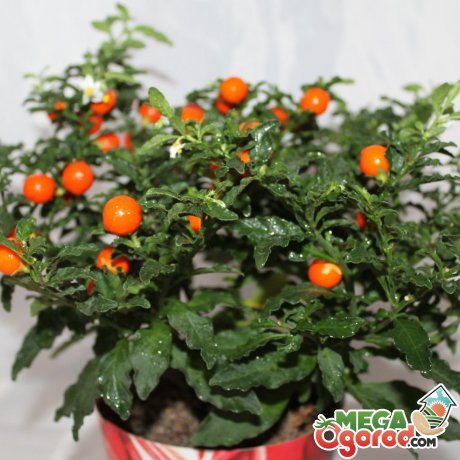

In the event that solanum is in conditions of excessive dryness, then it can be attacked by a whitefly, spider mite or aphid.
- Whitefly has white wings and infects solanum foliage. This pest appears mainly with stale air in the room, as well as with the accuracy of plants. The fight against this pest is carried out in several stages. Initially, you need to make the whitefly rise into the air. To do this, you just need to approach the plant.After this pest rises into the air, it will need to be collected with a vacuum cleaner. The plant during the fight against whitefly is best placed in a room, the temperature of which will correspond to an indicator of 14-15 degrees. Also, solanum must be treated with insecticides, which can be purchased at a regular store.
- The spider mite is very small and reddish-brown in color. This pest feeds on cell sap, which is extracted from the foliage of the plant. As a result, the leaves of solanum become yellow-green in color. At the first signs of the appearance of a spider mite, it is necessary to tear off all damaged leaves, and place the flower itself under a stream of water. Further, solanum must be treated with a special agent that is designed to combat this pest.
- Aphids on solanum can appear by putting them on clothes from the street, as well as as a result of their flight from other plants. It is most often located on the lower part of the foliage, which withers, clusters and dries up. This pest spreads very quickly, so at the first signs of its appearance, you must immediately begin to fight it. To do this, it is necessary to rinse the ground part of the plant under the shower and, after it dries, treat it with pesticides. You can also use tomato tops to combat aphids, which are crushed and infused with water. It is necessary to process the ground part of the solanum with this liquid.
Solanum is a rather whimsical plant to care for. But its good looks deserve it. If you carry out timely watering, airing and fertilizing this flower, then you can achieve very good results.
It is also very important for solanum to ensure the optimal temperature and humidity in the room. Anyone can perform these simple actions, one hundred will have a beneficial effect on the growth and development of this flower.
More information can be found in the video.
Zombies in modern culture


So when is the zombie apocalypse? Most likely never. Zombies are simply a promoted brand that is created to make money. This image symbolizes human phobias, something terrible that can be encountered in life. And many make money from these phobias. Today, almost everyone knows who zombies are, what they look like, what they eat and how to kill them. And all this thanks to modern culture: cinema and literature. In communication, the words "zombies", "apocalypse", "walking dead" and so on are increasingly used. Some universities around the world are studying zombies as a cultural phenomenon. Students are engaged in considering the question of why a huge number of films about these monsters have been made recently, and what interests the common person in them. Every year in different countries of the world there is a procession of a large number of people disguised as the dead. Sociologists and psychologists are still studying this phenomenon.
Preparing for the apocalypse
Today, almost everyone knows what zombies look like. They embraced popular culture quickly enough, appearing in movies, books, video games, and so on. The fear of the crowds of the dead who wish to feast on living flesh is deeply imprinted in the minds of Americans. Therefore, in many weapon stores, so-called anti-zombie kits began to appear, which included real knives, shotguns, and more.
Comedian Mel Brooks has released Apocalypse Survival Guide, which is the basis for the acclaimed World War Z movie. The Pentagon has developed a plan CONOP 888, which describes the actions to attack the zombies. Exercises are regularly held in Kansas, so everyone is ready for the moment when there will be a zombie apocalypse. Also, this topic is highlighted by the media, periodically giving out news, which, of course, are ducks.
But most people tend to believe a fake, so they are seriously preparing for a massive epidemic. For example, several years ago it was reported that on the shore of about. St. Thomas was discarded a male body with peeled skin. Upon the arrival of the police, the drowned man stood up and attacked them. Law enforcement officers started shooting at the man, but this had no effect, so they began to retreat. One of the observers grabbed a pistol and shot the dead man in the head, from which he died. The body was taken away by the military, who later claimed that zombies existed in real life. A few years later, the Minister of Australia, before the date of the expected end of the world (12.12.2012), made a statement that she was ready to protect her people from the walking dead.


How to transplant solanum
Ornamental tomato is transplanted as needed (when the solanum grows strongly). The most suitable time for transplanting is early spring.
The soil requires loose, water and air permeable, neutral according to the reaction. A soil mixture consisting of two parts of peat or humus soil, two parts of sod land and one part of sand is suitable.
Nightshade needs frequent watering, and so that moisture does not stagnate in the pot, you need a good drainage layer and drainage holes at the bottom of the container. Expanded clay, pebbles, clay shards, small stones, brick chips, pieces of polystyrene are used as drainage; you can mix several components or use each material yourself.
Increase the diameter of the container with each transplant by a few centimeters. Transplant the plant using the transshipment method so as not to damage the root system.
Temperature regime
Another important point is the air temperature. A plant that pleases with its originality all year round - solanum - loves special care at home. That is why it is important to maintain the temperature in the range of 18-25 ° in summer and spring, and from 12 to 15 ° in the autumn. These conditions must be met. Otherwise, nightshade will not bloom and bear fruit. As for the winter time, drops and drafts, as well as hot air from radiators, can have a bad effect on the plant. The leaves will begin to turn yellow and fall off. The same will happen with fruits.
After flowering
A decorative miracle blooms in spring or early summer with small nondescript flowers, collected in tassels of a white or blue hue. But the main beauty appears after flowering in the form of elegant bright fruits. They can be orange, yellow or red, depending on the species. Fruitful period
continues until the beginning of winter. In False Nightshade, it can last until February, so it gets a very short "rest".
Beautiful cutaway fruits are used for finishing and forming decorative bouquets.
How to prune and propagate solanum?
Pruning is the most important agricultural activity. It should be started six months after planting, when the lateral branches move into growth. Otherwise, you risk getting an awkward, elongated plant, and not a compact neat bush. How to trim pseudocapsicum solanum correctly - there are several tips on this topic:
- primary pruning consists in pinching all overgrown branches at the level of the second bud;
- re-pruning is required at the moment when the lateral shoots have reached a height of 10 cm. They are shortened to the level where 2 buds are located;
- anti-aging pruning is carried out every fall;
- in spring, with the help of pruning, the bush is given the correct shape - for this, all the branches are pruned in such a way that the shape of a ball is obtained.
At home, you can propagate solanum by cuttings and sowing ripe seeds. Seedlings are planted in mid-February in soil suitable for sowing peppers and tomatoes. The soil should be half organic humus and 2 parts of sod land.Mineral complexes are added as needed. Sowing is carried out in a continuous way, from above the seeds are covered with 5 mm of soil. Seedlings appear after 3-4 weeks. A pick into separate containers can be carried out when the first pair of true leaves appears. Landing on a permanent place of growth is carried out at the end of April. And already in July, the first pruning is required. Propagation of solanum by cuttings is also a fairly simple procedure. After pruning, twigs with a length of more than 10 cm are selected. They are immersed by 1/3 in warm water with the addition of kornivin. After 2 weeks, white roots appear and the cuttings are ready for planting in the ground. After planting, the pot can be placed in the greenhouse or the cuttings can be covered with a glass jar of sufficient volume.
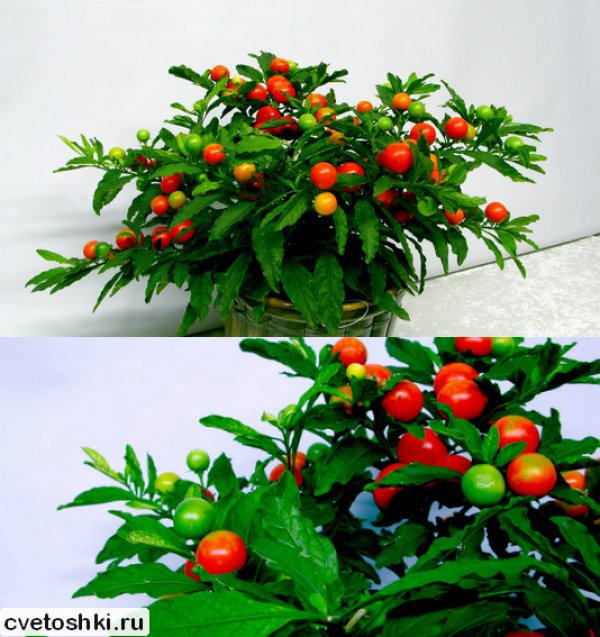

Solanum (Solanum) is a small evergreen shrub, strewn with small bright red or coral fruits in winter, for which the plant was named coral bush. The culture comes from tropical and subtropical regions of South America, Mexico, Cuba.
With proper care at home, Solanum usually grows up to 45-60 cm. There are also undersized dwarf forms. The leaves of the tree are dark green with wavy edges.
After abundant flowering at the beginning of winter, fruits ripen, which look spectacular against the background of dense foliage. Remember that berries are poisonous and can cause stomach upset, so it is not recommended to grow the crop in a home with children or pets.
Apocalypse problem
The zombie apocalypse is a fantastic scenario of many horror films, where some viral infection turns healthy people into living dead, cannibals, which are aggressive, and this leads to the extinction of the Earth's population.
In 1968, real zombies in the form of bloodthirsty dead were introduced into culture thanks to the film "Night of the Living Dead". After this, the concept of the apocalypse began to act as standard samples, which were applied to many areas of popular culture. The scenarios of the fictional apocalypse involve the invasion of zombies with an infectious virus like an epidemic of a real disease. The bite of a walking dead person contributes to the death of a person and his subsequent transformation into a monster that is eager to attack living people. The military and police cannot deal with such a massive threat, so those who survived must fight.
The script also describes how to defend against zombies. To do this, you need to find a weapon and a car in which to go to a deserted place and settle there. You must first stock up on food, clothing, water, medicines and various equipment.
Is homemade nightshade a danger?
Any part of the nightshade is poisonous. In no case should you eat berries. They taste unpleasant, bitter, but small children can eat them out of curiosity. Despite the fact that they most likely will not eat a large amount of these fruits, they will most likely have indigestion. And it also happened that the child swallowed the fetus whole or thrust it into the respiratory tract.
Indoor nightshade is a dangerous plant, and it is not advised to grow it in the apartment where there are small children, it would be better to wait until they grow up.
Solyanum pseudocapsicum: description and characteristics of the flower
The plant is a bush, consisting of thin twigs with an abundance of lush green foliage. But more attention is drawn to the orange balls of the fruit.
An evergreen perennial has a highly branched rhizome, which is located mainly on the surface.
A dense, practically impenetrable crown is formed from upright, highly branched stems. The branches of a young plant quickly become lignified, covered with brownish bark.
Leaves are oval (length from 5 to 10 cm, width from 2 to 5 cm), arranged alternately on the shoots.The surface is glossy with signs of waviness along the lateral edge and a clearly visible pattern of veins.
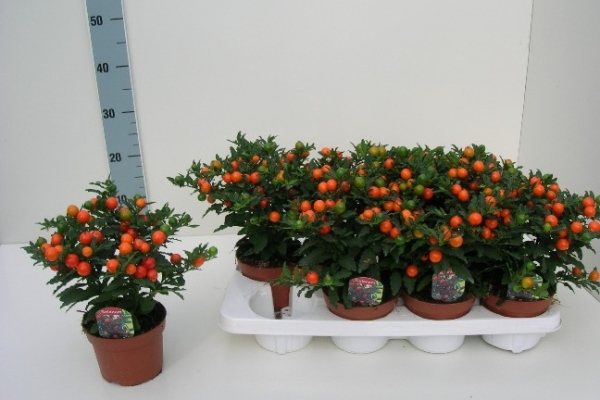

Solanum is an evergreen perennial shrub with a height of 45 - 120 cm
Read also: Growing alder irgi: planting and care in the garden
Indoor solanum blooms in the summer.... On the shoots, loose inflorescences of the umbrella or paniculate type become noticeable. Small buds (1-3 cm in diameter) are pink, lavender or white.
Being close to the plant, you can enjoy a light pleasant aroma. Later, round-shaped berries appear in place of the bells. The elastic skin of the fruit is colored red, orange, black or yellow tone. The diameter of ripe berries is 4-5 cm.
If there is a decrease in fruiting, you need to pollinate the flowers yourself using a brush during the next flowering period.
It should be noted that solanum is short-lived; in city apartments, with normal care, a plant can live for 3-5 years... Therefore, many growers advise not to transplant the bush, but to root cuttings taken from it.
Conditions for growing solanum:
Cuttings
The stalk is selected from cut twigs no more than 10 cm long and immersed one third of the length in warm water with the Kornevin biostimulator. After the roots appear (about two weeks), the cutting is planted in the ground. For the solanum to develop more actively, you can cover the pot with a large glass jar, creating the effect of a greenhouse.
When the nightshade reaches a height of 15 cm, pinching is carried out. To stimulate the growth and branching of solanum, it is pruned several times before the end of summer.
Description and photo of solanum - first acquaintance
The description of the culture may take several pages, but let's not tire with boring and dry veils from the botanical library. Still, this is the first acquaintance with an unusual shrub. The solanum flower is a prominent representative of the nightshade family, which are poisonous. It has no special requirements for the environment, but a lack of sunlight can lead to excessive stretching of branches and the loss of an attractive appearance. Look at the photo of solanum - the ripening period of the fruit makes it a real handsome man: In the first year of development, the shrub requires an attentive approach to the formation of a beautiful crown. It is necessary to cut off the stretching shoots in a timely manner. After 1.5 - 2 years, snow-white buds bloom in the axils of the leaves, inside which there is an ovary. Without exception, all varieties belong to self-fertile crops, which allows you to successfully set berries in room conditions without external pollination. Experienced flower growers recommend vigorously shaking the plants once a day during mass flowering. This improves the fruit setting rate. Can the fruits of solanum be eaten or used in any way? No, this is strictly prohibited. The berries contain the strongest poison - solanine. Keep children and pets safe. They should not have access to bushes.
Nightshade indoor
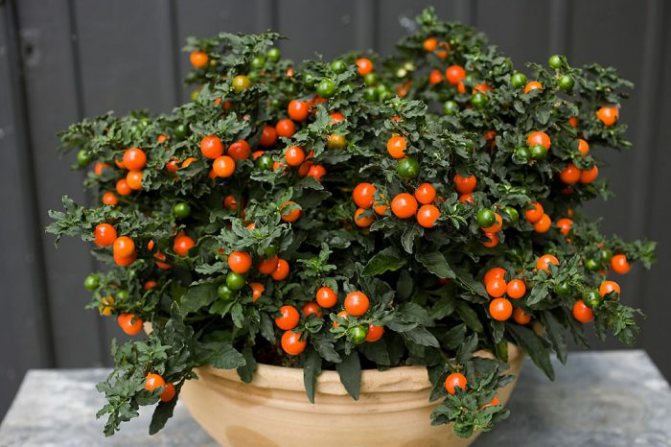

Genus nightshade or, as it is also called, solanum (Solanum) is directly related to the nightshade family. In this genus, there are about 1000 species, among which there are both herbaceous plants and shrubs, as well as trees. They grow in temperate and warm climates around the globe. Under natural conditions, most often nightshade can be found in South America, the homeland of eggplant, tomato and potato.
At home, only a few species are grown, which include False-Pepper nightshade (Solanum pseudocapsicum). This plant is native to several places at once, namely: from Ecuador, Peru, as well as the island of Madeiro. Under natural conditions, today it can be found in a large number of countries around the world, and in Australia for several centuries it has turned into a weed, which is not so easy to get rid of, which is a confirmation of the unpretentiousness of this nightshade.
Such an evergreen plant is compact and is not a very tall shrub. In the wild, it can reach a height of 100 centimeters, at home - somewhat less. Its lanceolate dark green leaves have slightly wavy edges, as well as short petioles.
Its white small flowers are collected in not very large racemose inflorescences, or they are single. Flowering can begin any month. However, the main decoration of this plant is its hearth. The fruit is a rounded berry with a diameter of 1 to 1.5 centimeters. They are colored red or rich orange. The fruits do not fall for a long time, so the bush is "decorated" almost all winter. In order to increase the time the berries stay on the bush, the nightshade should be placed in a cool room.
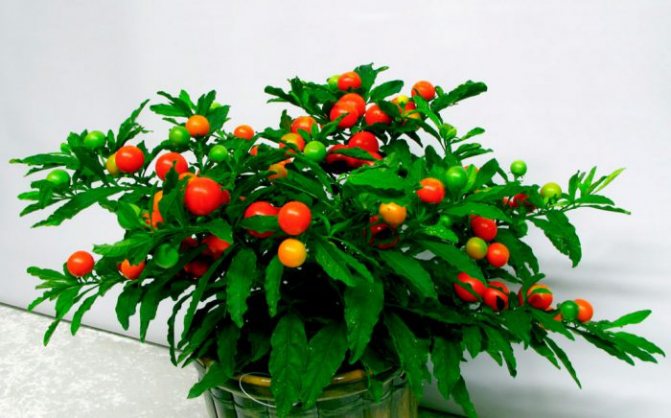

The dwarf forms of this house plant are most popular. They reach a height of no more than 30 centimeters, and their lush bushes are covered with a large number of berries. This plant is unpretentious to care for and can be purchased in almost every specialty store. Often they are sold in winter, because it is during this period that such nightshade is one of the few plants that look very impressive.
Edible fruit
Despite the external attractiveness of the fruits of solanum, they are poisonousas they contain the poisonous glycoalkaloid solanine and can lead to severe stomach upset. These berries can be especially dangerous for children and pets, so their access to the plant should be protected.
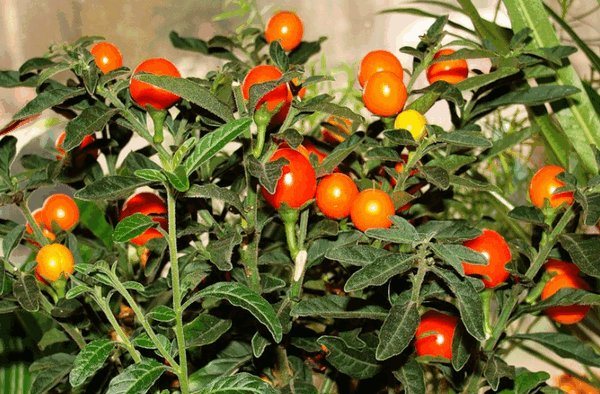

However, ripe berry-based products are successfully used in traditional medicine recipes, for example, for the treatment of sore throats.
Did you know? The Latin specific name of nightshade gave the name to one of the heroes of the opera "Love Potion" by the Italian composer G. Donizetti - the charlatan doctor Dulcamar.
the walking Dead
Today, almost everyone knows what zombies look like. These are the walking dead who embody evil. They are endowed with unmotivated rage, aggression towards the living, severe hunger, and walk in packs. Their brains are affected, body functions do not work, tissues are decomposed. But in all this there is no logic, such creatures are observed only in pop culture and have nothing to do with reality.
This zombie image was created for the plots of films for the purpose of the box office. After all, it is the dead that are most afraid of people who believe in the zombie apocalypse. Science refutes the possibility of the existence of such walking dead. So, it has been proven that metabolic processes do not occur in a dead body, there is no tissue regeneration, there is no biochemistry in it that is capable of providing thinking, movement, reflexes and aggression itself. It follows that zombies in real life will not be able to walk, since they have no internal energy for it. Since the bonds between the tissues are very loose, they would simply fall apart. In addition, the dead have no digestion, so they cannot eat their victims.



